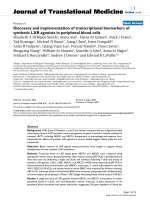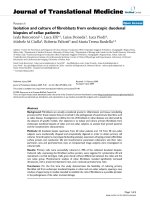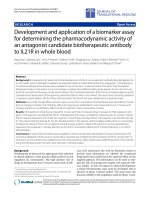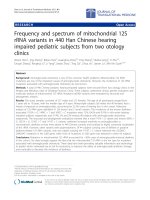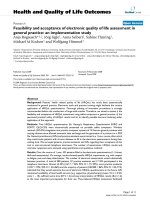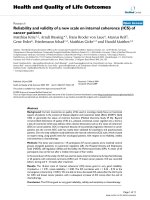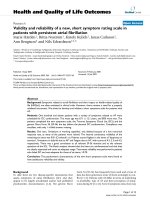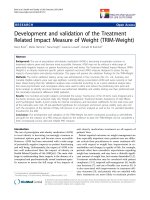Báo cáo hóa học: " Fabrication and evolution of multilayer silver nanofilms for surface-enhanced Raman scattering sensing of arsenate" pdf
Bạn đang xem bản rút gọn của tài liệu. Xem và tải ngay bản đầy đủ của tài liệu tại đây (1009.25 KB, 11 trang )
NANO EXPRESS Open Access
Fabrication and evolution of multilayer silver
nanofilms for surface-enhanced Raman
scattering sensing of arsenate
Jumin Hao
1†
, Mei-Juan Han
1†
, Zhonghou Xu
1
, Jinwei Li
2
and Xiaoguang Meng
1*
Abstract
Surface-enhanced Raman scattering (SERS) has recently been investigated extensively for chemical and
biomolecular sensing. Multilayer silver (Ag) nanofilms deposited on glass slides by a simple electroless deposition
process have been fabricated as active substrates (Ag/GL substrates) for arsenate SERS sensing. The nanostructures
and layer characteristics of the multilayer Ag films could be tuned by varying the concentrations of reactants
(AgNO
3
/BuNH
2
) and reaction time. A Ag nanoparticles (AgNPs) double-layer was formed by directly reducing Ag
+
ions on the glass surfaces, while a top layer (3rd-layer) of Ag dendrites was deposited on the double-layer by self-
assembling AgNPs or AgNPs aggregates which had already formed in the suspension. The SERS spectra of arsenate
showed that characteristic SERS bands of arsenate appear at approximately 780 and 420 cm
-1
, and the former
possesses higher SERS intensity. By comparing the peak heights of the approximately 780 cm
-1
band of the SERS
spectra, the optimal Ag/GL sub strate has been obtained for the most sensitive SERS sensing of arsenate. Using this
optimal substrate, the limit of detection (LOD) of arsenate was determined to be approximately 5 μg·l
-1
.
Introduction
Since the discovery of surface-enhanced Raman scatter -
ing (SERS) in the late 1970s, SERS has been extensively
studied as a sensitive analytical technique for fundamen-
tal studies of surface species [1-6]. The development of
SERS substrates with high sensitivity and good reprodu-
cibility has been one of the most challenging tasks. Col-
loidal Ag or Au nanoparticles are the most widely used
SERS substrates. The aggregation of the colloidal parti-
cles facilitating the formation of “hotspots” appears to
be crucial for strong SERS enhancement [7-11]. How-
ever, the aggregation of colloidal particles is dif ficul t to
control, thus leading to poor reproducibility of both
substrates and SERS s ignals [12,13]. Although the
immobilization/assembly of c olloidal nanoparticles onto
solid supports could improve the controllable aggrega-
tion of the nanoparticles to some extent, the synthesis
and fabrication processes for such assembled layers are
usually laborious and time consuming, and usually
require the use of organic molecules acting as reduc-
tants, stabilizing reagents, or coupling reagents.
In recent years, extensive efforts have been dedicated to
developing stable nanostructured Ag or Au surfaces
directly on solid substrates using various techniques
including vacuum evaporation [14], sputtering [15], elec-
trochemical deposition [16], thermal decompo sition [17],
and electroless plating [18-20]. The electroless plating of
nanostructured metal films is attracting much attention
due to its easy production, uniform coating, low cost, and
no need for special and expensive equipments. A galvanic
displacement reaction is a simple electroless plating
process to prepare SERS-active Ag or Au films on metal
and semiconductive substrates like copper, germanium,
and silicon [19-22]. However, it cannot be applied to
dielec tric substrates like cheap glass slides. Although the
well-known mirror reaction is suitable for the deposition
of Ag nanofilms onto glass surfaces, this process includes
multi-step reactions and requires complex reagents,
resulting in difficulty in controlling the surface roughness
of the resulting Ag films [20,23,24].
SERS-based techniques have been widely applied to
chemical, biological, and medical sensing because SERS
has been believed to be one of the most sensitive
* Correspondence:
† Contributed equally
1
Center for Environmental Systems, Stevens Institute of Technology,
Hoboken, NJ 07030, USA.
Full list of author information is available at the end of the article
Hao et al. Nanoscale Research Letters 2011, 6:263
/>© 2011 Hao et al; licensee Springer. This is an Open Access article distributed under the terms of the Creative Commons Attribution
License ( whic h permits unrestricted use, distribution, and reproduction in any medium,
provided the original work is properly cited.
spectroscopic methods [1,2,5,10,25-27]. Most recently,
SERS technique for environmental analysis and monitor-
ing has been reviewed by Halvorson and Vikesland [25],
and Alvarez-Puebla and Liz-Marzan [27], respectively.
The SERS detections of some inorganic environmen-
tal pollutants such as perchlorate (ClO
4
-
) [21,28,29],
arsenate (AsO
4
3-
) [23], chromate (CrO
4
2-
) [30], uranyl
(UO
2
2+
) [31,32], cyanide (CN
-
) [30], and thiocyanate
(SCN
-
) [33] have be en investigated. Arsenic ( As) is one
of the most toxic contaminants found in the environ-
ment, and long-term exposure to arsenic can cause var-
ious cancers and other serious diseases [34,35]. Based
on the World Health Organization (WHO) guideline,
many countries including the US have promulgated a
more stringent drinking water standard for arsenic with
a maximum contaminant level (MCL) of 10 μg·l
-1
(ppb)
[35,36]. There exists an urgent need for the develop-
ment of methods for effective monitoring and measure-
ment of arsenic in the field [37,38].
Currently, the commonly used laboratory methods
such as atomic fluorescence spect roscopy (AFS), atomic
absorption spectroscopy (AAS), inductively coupled
plasma-atomic emission spectrometry or mass spectro-
metry (ICP-AES or ICP-MS) allow the detection of low
arsenic concentration, but they are expensive, bulky, and
usually involved in sophisticated and time-consuming
preparations of the samples, making them infeasib le for
field assays. Moreover, these techniques cannot distin-
guish different arsenic species, such as arsenite (As(III))
and arsenate (As(V)), without sample pretreatments. In
this case, the SERS technique, which can be used in
conjunction with commercially available portable Raman
systems, has emerged as a potentially promising solution
in field assays due to its ability to provide ultrasensi tive,
reliable, non-invasive, n ondestructive, fast, simple, and
cost-effective measurements. It has been demonstrated
that SERS technique is able to identify, detect, and
screen single and multiple contaminants simultaneously
in a small volume of sample [25,27]. More significantly,
it is incomparable in speciation analysis including distin-
guishing among the arsenic species with no need for any
complex sample preparation because it can provide a
nice “fingerprint” of materials of interest [38]. The first
SERS spectrum of arsenate at high concentrations
(> 100 mg·l
-1
) was reported by Greaves and Griffith [39]
using silver sols. Recently, Mulvihill et al. [38] fabricated
Langmuir-Blodgett (LB) monolayers of polyhedral Ag
nanocrystals for arsenate SERS detection in groundwater
samples with low concentrations (< 10 μg·l
-1
). Most
recently, we examined the effect of ions on the arsenate
SERS sensing using Ag nanofilms prepared by modified
mirror reaction [23].
In this articl e, a controllable one-s tep electroless plat-
ing process was applied to directly deposit multilayer Ag
nanofilms on glass slides (Ag/GL substrates) for effective
SERS sensing of arsenate. The Ag/GL substrates pre-
pared under different conditions were characterized by
SEM and UV-Vis spe ctra, and the formation mechan-
isms of the multilayer films were discussed. The SERS
spectra of arsenate on Ag/GL substrates were analyzed.
The relation between the preparation conditions, the
resulting morphology of the Ag nanofilms, and the
SERS sensitivity to arsenate w as examined to optimize
the Ag nanofilms for arsenate SERS sensing. Using opti-
mized substrates, the limit of detection of arsenate was
determined.
Experimental
Materials
Sodium arsenate (Na
3
AsO
4
·7H
2
O) and silver nitrate
(AgNO
3
) were purchased from Fisher Scientific (Fair
Lawn, NJ, USA). Butylamine (BuNH
2
) was obtained
from Sigma-Aldrich ( Milwaukee, WI, USA). Anhydrous
ethanol (Pharmco-AAPER, Brookfield, CT) wa s used as
a plating solvent. All other chemicals were analytical
grade and purchased from Sigma-Aldrich or Fisher
Scientific and used as received. Deionized (DI) water
with a resistivity of 18.2 MΩ·cm (Millipore Milli-Q Sys-
tem) was used throughout the experiments. Aqueous
arsenate samples in the concentration range 0-300 μg·l
-1
were prepared by diluting a stock solution of 10
6
μg·l
-1
with DI water.
Preparation of Ag nanofilms
The Ag films deposited on glass slides were prepared by
reduction of AgNO
3
with BuNH
2
in anhydrous ethanol
using 6-well plates as reaction vessels, without stirring at
room temperature (approximately 22°C). The glass sli des
were cut into 1 × 1 cm
2
, which were cleaned in piranha
solution (a mixture of concentrated H
2
SO
4
and H
2
O
2
(30%) with a volume ratio of 70 to 30) at approximately
80°C for 1 h. After being washed wit h DI wat er, these
glass slides were sonicated in 1 M NaOH solution for 30
min to obtain negatively charged surfaces for improved
Ag
+
adsorption on them during t he AgNPs deposition
followed by washing with DI water and ethanol in
sequence, and then dried under a stream of compressed
nitrogen gas. The cleaned glass slides were put into the
wells of the 6-well plates (three slides in each well/batch)
and a 14 ml fresh prepared ethanolic AgNO
3
/BuNH
2
solution was added into each well within 10 min. The
concentrations of AgNO
3
/BuNH
2
in ethanol used in t he
experiments were 1/0.5 mM, 5/2.5 mM, and 10/5 mM
(a constant ratio of 2:1). After a period of reaction time
(0.5 to 40 h), o ne batch of Ag/GL substrates were rinsed
with ethanol and dried under a stream of compressed
nitrogen gas. Here, all the Ag/GL substrates are labeled
as Ag/GL-c/c-t, where “ c/c” and “ t” represent the
Hao et al. Nanoscale Research Letters 2011, 6:263
/>Page 2 of 11
concentrations of the AgNO
3
/BuNH
2
ethanolic solution
in “mM” and the reaction time in “hours ” or “h”,respec-
tively. For example, Ag/GL-5/2.5-18 means an Ag/GL
substrate which is prepared in the ethanolic solution con-
taining 5 mM AgNO
3
and 2.5 mM BuNH
2
with the reac-
tion time of 18 h.
Instruments and methods
The morphology and microstructure of the Ag/GL sub-
strates were examined using a field-emission scanning
electron microscope (FESEM) (LEO 982, LEO Electron
Microscopy Inc., Thornwood, NY, USA) operated at an
accelerating voltage of 5 kV and a working distance
(WD) of 6 mm. UV-Vis absorbance spectra were
recorded with a Synergy™ HT Multi-Detection Micro-
plate Reader (BioTek Instruments Inc., Winooski, VT,
USA) with 2 nm resolution in the wavelength range
between 350 and 750 nm, and a clean ed glass slid e was
used as a background. For SERS analysis, 10 μlof
arsenate solution was dropped onto the Ag/GL substrate
and a sample droplet with a diameter of approximately
3 mm was formed. After air-dried, the SERS spectra
were collected in high resolution mode on a Thermo
Nicolet Almega XR Dispersive Raman Spectrometer
(Thermo Fisher ScientificInc.,Madison,WI,USA)
equipped with a CCD detector, an optical microscope
and a digital camera, an d a 780 nm laser line with a
laser source power of 30 mW (50% power was applied
in the experiments). The Raman band of a silicon wafer
at 520 cm
-1
was used to calibrate the spectrometer. All
the measurements were conducted in the backscattering
geometry. A 10 × microscope objective was used, pro-
viding a laser spot size of 3.1 μm. The data acquisition
time was 3 s per scan and five scans were used for each
spectrum collection. For reliable and reproducible SERS
measurements, a mapping method was employed and an
averaged spectrum was obtained by averaging 25 spectra
splitted from a mapping result with a scan area of 2 ×
2mm
2
, a step size of 0.5 × 0.5 mm
2
(X × Y).
Results and discussion
Characterization and evolution process of Ag nanofilms
To investigate the evolution of the nanostructured Ag
films and the relationship between the Ag film st ructures
and the SERS effect, the surface morphologies of the
Ag/GL substrates were characterized by SEM observa-
tion. F igure 1 presents typical SEM images of the Ag/GL
substrates prepared in a 5/2.5 mM AgNO
3
/BuNH
2
solu-
tion at different reaction time s of 1.5-40 h. At the begin-
ning stage of the reaction (≤ 2 h), a thin monolayer
(1st-layer) consisting of small sphere-like Ag NPs formed
on the glass surfaces as shown in Figure 1a,b. Most of
AgNPs in the monolayer were isolated from their nearest
neighbors for the 1.5 h reaction t ime (Figure 1a). As the
reaction time increased to 2 h, the AgNPs grew and
some of them appeared to contact each other, and the
AgNPs monolayer exhibited a close-packed structure.
By continuously raising the reaction time to 5-40 h,
newly reduced Ag atoms would grow on the top of the
well-defined 1st-layer AgNPs to form second layer
AgNPs (2nd-layer) as shown in Figure 1c,d,e,f. The 2nd-
layer AgNPs were much larger than those in the 1st-
layer and kept growing in particle size and coverage
degree as the reaction time was prolonged. When a
growing AgNP met another growing AgNP, coalescence
of AgNPs occurred, which led to aggregated and
agglomerated AgNPs congeries with irregular shapes
and structures (Figure 1d,e,f). Figure 1e,f also indicate
that the growth of the 2nd-layer AgNPs in the direction
normal to the substrate surface was notable. It was also
observed that the growth of the 1st-layer AgNPs was
depressed when the reaction time was > 5 h probably
due to the formation of the 2nd-layer Ag NPs on its top
and the competition between the two layers. It is also
likely that the formation of the 2nd-layer AgNPs par-
tially consumed the 1st-layer AgNPs through aggrega-
tion to lead to the depressed growth of the 1st-layer
AgNPs. In additio n, when the reaction time was > 9 h,
some dendrites formed on the top of the double-layer
with a statistically uniform distribution (figure not
shown). The dendrite layer could be regarded as a 3rd-
layer although its coverage degree was low. The mean
particle sizes in the 1st-layer and 2nd-layer are listed in
Table 1.
The time-dependent evolution of the microstructures
of Ag/GL substrates discussed above was also observed
when lower or higher AgNO
3
/BuNH
2
concentr ations
were used. Note that almost no Ag d endrites were
observed when the AgNO
3
/BuNH
2
concentrations were
1/0.5 mM. The higher the AgNO
3
/BuNH
2
concentra-
tions were, the faster the Ag deposition occurred.
The Ag nano films were found to exhibit strong plas-
mon absorption. Figure 2 shows the UV-Vis absorption
spectra of the Ag films prepared at different reaction
times for three different concentrations of reactants. It
was found that the b andwidth of the plasmon resonance
peak varied with the reaction time, especially for the
1/0.5 mM AgNO
3
/BuNH
2
reaction solution. The plots
of maximum absorption wavelength (l
max
)andthe
absorbance at l
max
against the reaction time are shown
in Figure 3A,B, respectively. Figure 3A shows that l
max
of the Ag films increased (shifted to longer wavelength)
with the reaction time at the initial reaction stage, indi-
cating that the size of AgNPs was increasing during this
period [24,40]. It is interesting that when a maximum
(1st turning po int) was reached within 2-5 h, the l
max
started to descend till a valley occurred (2nd turning
point) followed by another increase. By comparison with
Hao et al. Nanoscale Research Letters 2011, 6:263
/>Page 3 of 11
the SEM images, we noticed that the 1st turning point
was right around the reaction time when the 2nd-layer
AgNPs started to appear. The formation of the 2nd-
layer AgNPs and their growth in the direction normal
to the substrate surface might lead to decrease in their
diameter-to-height (a/b) ratio, and consequently a
decrease in l
max
[41]. The second rise in l
max
was prob-
ably related to the formation of the 3rd-layer Ag den-
drites. Since only few Ag dendrites were observed on
the film prepared in the 1/0.5 mM AgNO
3
/BuNH
2
solu-
tion, the second increase in l
max
for these samples
appeared to be much slower than others.
Unlike the undulatory variation of l
max
,theabsor-
bance at l
max
of each UV-Vis spectrum increased con-
sistently with reaction time as shown in Figure 3B. This
means that the density of AgNPs or the thickness of the
Ag films kept increasing throughout the reaction [42].
This increase exhibited a rapid kinetics at the initial
reaction stage, followed by a relatively slow one. In
short, the factors determining l
max
, absorbance and
bandwidth of the plasmon resonance are multifaceted,
including the size, shape, and density of the metal parti-
cles, dispersion of particle sizes and their aggregation on
the substrates [40-43]. Table 2 lists the maximum l
max
,
valley l
max
, and the corresponding reaction time needed
to reach them for the three reaction systems.
There may be two mechanisms in the formation pro-
cess of the multilayer Ag nanofilms: (1) Ag
+
was
reduced to AgNPs/nanostructures by BuNH
2
directly on
the glass surfaces; (2) AgNPs/nanostructures were
formed in the ethanol and then assembled on the glass
surfaces. When the 1/0.5 mM AgNO
3
/BuNH
2
were
used, the reaction solution did not change in color and
remained transparent througho ut the reaction. The UV-
Vis spectra of the reaction solution were recorded at dif-
ferent reaction t imes and did not indic ate a significant
difference among them (data not shown). This could
suggest that the AgNP double-layer film was formed
directly on the substrates following the first mechanism:
Ag
+
was first anchored on the negatively charged glass
substrates (NaOH treated) followed by BuNH
2
reduction
to form AgNP seeds. Then more Ag
+
ions were reduced
onto the seeds resulting in the AgNPs growth and the
formation of the Ag double-layer film.
For the reaction solution of 5/2.5 mM AgNO
3
/BuNH
2
,
the Ag double-layer film had been formed at approxi-
mately 5 h (see Figure 1c); while the color of the reac-
tion mixture was found to start to become yellow at
approximately 7 h. As the reaction time was prolonged,
the color became darker and darker, and the transpar-
ency decreased gradually, sugge sting that a bulk reduc-
tion took place and the AgNPs were formed in the
Figure 1 SEM images of AgNPs multilayer films on glass slides prepared in a AgNO
3
/BuNH
2
(5/2.5 mM) ethanolic solution with
different reaction times: (a) 1.5 h, (b) 2h,(c) 5h,(d) 18 h, (e) 25 h, and (f) 40 h.
Table 1 The mean sizes of the AgNPs in the double-layer
Ag films prepared in 5/2.5 mM AgNO
3
/BuNH
2
solution at
different reaction times of 1.5-40 h
Reaction time (h) Size of AgNPs (nm)
1st-layer 2nd-layer
1.5 20 ± 5 /
2 35 ± 10 /
5 40±8 60±15
18 35 ± 12 80 ± 20
25 45 ± 10 150 ± 30
40 50 ± 10 180 ± 30
The mean sizes were obtained by averaging the diameters of 15-50 particles
in each layer.
Hao et al. Nanoscale Research Letters 2011, 6:263
/>Page 4 of 11
reaction mixture. As time went on, the AgNPs aggre-
gated and precipitated on the bottom of the reaction
vessel and the surface of the Ag/GL substrates. A similar
phenomenon was also observed for the 10/5 mM
AgNO
3
/BuNH
2
solution. Compared with the 1/0.5 mM
AgNO
3
/BuNH
2
solution in which almost no A g den-
drites were observed on the A g double-layer film, the
above-mentioned appearanc e was an indicat ion that the
formation of the 3rd-layer Ag dendrites possibly fol-
lowed the second mechanism.
SERS spectra of arsenate on Ag nanofilms
Figure 4A shows typical background spectra (curves (a)
and (c)) and SERS spectra of arsenate (curves (b) and (d))
on the Ag/GL-1/0.5-25 and Ag/GL-5/2.5-18 substrates,
respectively. In the background spectrum (curve (a) in
Figure 4A) of the Ag/GL-1/0.5-25 prepared in lower con-
centrations of AgNO
3
/BuNH
2
, there existed some Raman
bands in the range of 300 t o 1200 cm
-1
. Their intensities
varied depending on the preparation conditions of the Ag
films. When the higher concentrations of AgNO
3
/BuNH
2
were used, the resulting Ag/GL-5/2.5-18 substrate had a
simpler background spectrum (curve (c) in Figure 4A).
Compared with th e background spectrum of the A g/GL-
1/0.5-25, the i ntensities of two Raman bands ce nter ed at
1046 ± 8 cm
-1
and 688 ± 3 cm
-1
are much higher, while
the other bands diminished or even disappeared.
In the SERS spectra of arsenate obtained on these two
Ag films as shown in Figure 4A (curves (b) and (d)),
most of the background bands could still be discerned
but the peak intensities were suppressed. The two char-
acteristic Raman bands of arsenate occurred at 780 ±
2cm
-1
and 420 ± 10 cm
-1
due to the υ
1
(A
1
) symmetric
As-O stretch and a superposition of υ
2
(A
1
)andυ
5
(E)
stretching modes of the arsenate molecule, respectively.
Our recent study demonstrated that the υ
1
(A
1
)sym-
metric As-O stretch resulted in a similar SERS band at
approximately 780 cm
-1
using Ag nanofilms made using
the mirror reaction [23]. Compared with the result
obtained from the LB monolayers of AgNPs [38], this
SERS band had a shift of approximately 20 cm
-1
to
lower frequency. Since the 780 cm
-1
SERS band hap-
pened to be more intense than the 420 cm
-1
SERS band,
and there were no serious interference bands around
the 780 cm
-1
position in the background spectra, its
intensity will be used to evaluate the SERS effects of
arsenate in the subsequent studies. However, the
arsenate SERS detection at low concentration using
Ag/GL substrates may suffer from the interference of
the nearest background band at approximately 815 cm
-1
.
Optimization of Ag nanofilms for arsenate SERS sensing
Figure 4B shows the SERS spectra of arsenate (200 μg·l
-1
)
on the Ag/GL substrates prepared in 5/2.5 mM AgNO
3
/
BuNH
2
solution at different reaction times of 2, 3.5, 5, 9,
18, 25, 31, and 40 h, respectively. It was of particular
interest t hat the Ag/ GL-5/2.5-18 as a SERS substrate
gave the most intense arsenate peak among all eight Ag/
K
K
K
K
K
K
K
C
K
K
K
K
K
K
K
K
B
Ab
sor
b
ance
K
K
K
K
K
K
K
K
K
A
Figure 2 UV-Vis absorption spectra of the AgNPs films prepared in AgNO
3
/BuNH
2
ethanolic solutions at different reaction time.The
reactants concentrations: (A) 1/0.5 mM, (B) 5/2.5 mM, and (C) 10/5 mM. The background spectra have been subtracted for all the UV-Vis
absorption spectra.
Hao et al. Nanoscale Research Letters 2011, 6:263
/>Page 5 of 11
Reaction time (h)
λ
max
(
nm
)
P0
P0
P0
A
Reaction time
(
h
)
Absorbance
P0
P0
P0
B
Figure 3 The plots of the maximum absorption wavelength (l
max
) and the absorbance at l
max
of UV-Vis absorption spectra of the
AgNPs films against the reaction time. (A) l
max
vs reaction time, and (B) absorbance at l
max
vs reaction time.
Table 2 The maximum l
max
, valley l
max
, maximum peak height of 780 cm
-1
band and the corresponding reaction time
needed them to reach for the three reaction systems
AgNO
3
/BuNH
2
(mM/mM) Maximum l
max
Valley l
max
Maximum SERS
Value (nm) Time (h) Value (nm) Time (h) Peak height Time (h)
1/0.5 494 5 464 25 4539 25
5/2.5 464 3.5 422 18 10831 18
10/5 468 3 427 9 10240 6
Hao et al. Nanoscale Research Letters 2011, 6:263
/>Page 6 of 11
GL substrates, while the peaks from Ag/GL-5/2.5-2 and
Ag/GL-5/2.5-40 substrates were extremely weak. This
clearly reflects the effect of the preparation conditions on
the SERS sensitivity of the substrates. In order to more
distinctly illustrate the results mentioned above, the peak
heights of the arsenate Raman bands were plotted against
the reaction time to yield a histogram (Figure 5B). From
the figure, we can see that as the reaction time was pro-
longed from 2 to 40 h, the peak height increased gradu-
ally until a maximum appeared, and then decreased. The
maximum peak height was obtained from the Ag/GL-5/
2.5-18 substrate.
5000
10000
15000
20000
25000
30000
35000
Int
400 600 800 1000 1200
Raman shif t (cm-1)
Raman shift (cm
-1
)
1200
R
a
m
a
n
i
n
t
e
n
s
i
t
y
5000
(
b
)
(
c
)
(
d
)
(
a
)
7
8
0
c
m
-
1
815 cm
-1
688 cm
-1
420 cm
-1
1046 cm
-1
A
5000
10000
15000
20000
25000
30000
Raman intensity
600 800 1000 1200
Raman shift (cm-1)
(
b
)
(
c
)
(
d
)
(
e
)
(
f
)
(
a
)
(g)
(h)
780 cm
-1
Raman shift (cm
-1
)
1200
R
a
m
a
n
i
n
t
e
n
s
i
t
y
5000
B
Figure 4 Typical SERS spectra of arsenate using various Ag/GL substrates as active substrates. (A) SERS spectra of arsenate: (a) 0 μg·l
-1
(background) and (b) 300 μg·l
-1
on Ag/GL-1/0.5-25 substrate; and (c) 0 μg·l
-1
(background) and (d) 250 μg·l
-1
on Ag/GL-5/2.5-18 substrate. (B)
SERS spectra of 200 μg·l
-1
arsenate on various Ag/GL substrates prepared in 5/2.5 mM AgNO
3
/BuNH
2
ethanolic solution at different reaction
times: (a) 2 h, (b) 3.5 h, (c) 5 h, (d) 9 h, (e) 18 h, (f) 25 h, (g) 31 h, and (h) 40 h. The samples were air-dried before SERS measurements. The
spectra were shifted vertically for clarity but the relative intensity was kept unchanged except for the curve a in (B).
Hao et al. Nanoscale Research Letters 2011, 6:263
/>Page 7 of 11
It is noticed that Ag/GL substrates covered by the
AgNPs monolayer film resulted in much lower SERS
enhancements than those covered by the AgNPs dou-
ble-layer film (see Figures 1, 5B). When 2nd-layer
AgNPs grew to 80 ± 20 nm in diameter (Ag/GL-5/2.5-
18), the maximum SERS enhancement was observed for
arsenate. The AgNPs with different sizes and shapes can
have very different enhancement effects. Ag part icles (or
aggregates) with size of approximately 90 nm are
reported to yield the highest S ERS enhancement [39].
Moreover, as stated b efore, the aggregated and agglom-
erated AgNPs congeries with irregular shapes and struc-
tures had been formed in the Ag/GL-5/2.5-18 . In this
case, more “ hotspots” or “ active sites” could exist
between two adjacent AgNPs or at the corners/e dges of
the irregular AgNPs in the double-layer film. The
arsenate ions adsorbed on “hotspots” or “ active sites”
might produce extremely strong enhancements. It is
possible that these two factors (suitable size of AgNPs
and more “hotspots” or “active sites”) contribute simul-
taneously to the remarkable SERS enhancement.
Similar reaction time-dependent profiles of SERS were
observed for the Ag/GL substrates prepared in both
lower (1/0.5 mM) and higher (10/5 mM) concentrations
of AgNO
3
/BuNH
2
solutions (Figure 5A,C). In summary,
for a given concentration of AgNO
3
/BuNH
2
concentra-
tion with constant molar ratio of 2:1, there was an opti-
mum reaction time yielding a substrate with the
maximum SERS enhancement. The higher the concen-
trations of the reactants were, the shorter the optimum
reaction time was. In our experiments, the optimal
Ag/GL substrate (i.e., Ag/GL-5/2.5-18) could be made
in 5/2.5 mM AgNO
3
/BuNH
2
ethanolic solution w ith a
reaction time of 18 h at room temperature. The maxi-
mumpeakheightofthe780cm
-1
band and the opti-
mum reaction time for each set of AgNO
3
/BuNH
2
concentrations are also listed in Table 2.
Comparing the results in Table 2, it is found that each
optimum reaction time is equal to or near to the time
needed to reach each valley l
max
(2nd turning point in
Figure 3A). It has been demonstrated that at the 2nd
turning points, the 3rd-layer Ag dendrites had formed
but still at the early stages for the two high concentra-
tions of AgNO
3
/BuNH
2
solutions. These observations
imply that the 3rd-layer Ag dendrites may play a signifi-
cant role in the arsenate SERS enhancements. Figure 6
presents the SEM images of the three optimized Ag/GL
substrates (Ag/GL-1/0.5-25, Ag/GL-5/2.5-18, and
Ag/GL-10/5-6) in both low magnification (large area)
and high magnifica tion (high resolution). The large area
SEM images show that some Ag dendrites with 1-5 μm
size appeared; larger area images (data not show n) show
the Ag dendrites were distributed uniformly on the dou-
ble-layer films of Ag/GL-5/2.5-18 and Ag/GL-10/5-6
substrates, while only few Ag dendrites were observed
on the double-layer film of the Ag/GL-1/0.5-25 sub-
strate. The high-resolution SEM images indicate that
there is not much difference in AgNPs properties and
microstructures among the three double-layer films
except that the AgNPs look a little more irregular in
the Ag/GL-5/2.5-18 substrate. The Ag dendrites consist
of small AgNPs of 20-50 nm. The previous study also
indicated that Ag dendrites are very SERS-active
[19,22,44,45]. Therefore, the two Ag/GL substrates with
Ag dendrites on them exhibited much higher SERS
effects than that without Ag dendrites. For a given
5HDFWLRQWLPH
K
3HDNKHLJKWDWFP
C
BA
Figure 5 Histograms indicating the change in peak heights of the 780 cm
-1
band with reaction time. The peak heights were measured
from the SERS spectra of 200 μg·l
-1
arsenate on the Ag/GL substrates prepared in (A) 1/0.5 mM, (B) 5/2.5 mM, and (C) 10/5 mM AgNO
3
/BuNH
2
ethanolic solutions with different reaction times.
Hao et al. Nanoscale Research Letters 2011, 6:263
/>Page 8 of 11
concentration of reactants, after the optimum reaction
time, some AgNPs in the Ag dendrites agglomerated
together to form big solid Ag masses (images not
shown), leading to the decreasing SERS magnitude.
Limit of detection of arsenate
The SERS spectra of arsenate on every optimized sub-
strate were measured in the concentration range 0-200
μg·l
-1
. Figure 7 shows the SERS spectra as a function of
arsenate concentration recorded on Ag/GL-5/2.5-18
substrate. It is clear that a steady decrease in SERS
intensity or peak height of the arsenate Raman band is
obs erved with decreasing arsenate concentration. When
the concentration is lower than 5 μg·l
-1
,thearsenate
SERS band at approximately 780 cm
-1
appeared to be a
shoulder of the 815 cm
-1
band, which is not easily dis-
cerned. Therefore, the LOD of Ag/GL-5/2.5-18 substrate
for arsenate was determined to be approximately 5 μg·l
-1
.
SERS sensing of low concentration arsenate may suffer
from the interference of the 815 cm
-1
background Raman
band. LODs of Ag/GL-1/0.5-25 substrate and Ag/GL-10/
5-6 substrate were also determined, and the relatively
high values are obtained, i.e., approximately 50 and 20
μg·l
-1
,respectively.
Conclusions
A simple one-step electroless deposition process has
been applied to prepare Ag/GL sub strates for arsenate
SERS sensing. Monolayer, double-layer, and multilayer
AgNPs films with different nanostructural characteristics
could be controllably deposited on glass by varying the
reactant concentrations and deposition times. Two for-
mation mechanisms have been proposed to lead to the
multilayer Ag films. The SERS spectr a of arsenate show
that characteristic SERS bands of arsenate appear at
approximately 780 and 420 cm
-1
, and the former pos-
sesses higher SERS i ntensity consistently regardless of
the film nanostructures and the arsenate concentrati ons.
By comparing the peak heights of the approximately
780 cm
-1
band of the SERS spectra, the most sensitive
Ag/GL substrate for arsenate SERS sensing has been
obtained in 5/2.5 mM AgNO
3
/BuNH
2
solution with a
deposition time of 18 h. This substrate is covered by a
multilayer film consisting of one double-layer of AgNPs
and one layer of Ag dendrites distributing uniformly over
the double-layer. The lowest arsenate LOD was deter-
mined to be approximately 5 μg·l
-1
on this substrate, indi-
cating its high SERS activity to arsenate.
Figure 6 SEM images of AgNPs multilayer films of the substrates: (a) Ag/GL-1/0.5-25, (b) Ag/GL-5/2.5-18, and (c) Ag/GL-10/5-6. The top
panels present the low magnification (large area) images, and the bottom panels are high magnification (high resolution) images indicating the
nanostructures of Ag double-layer films. The insets in (b) and (c) show the high-resolution images of the corresponding Ag dendrites.
6000
8000
10000
12000
14000
16000
Int
500 1000
cm-1
R
a
m
a
n
i
n
t
e
n
s
i
t
y
Raman shift (cm
-1
)
1200
780 cm
-1
(
b
)
(
c
)
(
d
)
(
e
)
(
a
)
Figure 7 SERS spectra of arsenate at the different
concentrations using Ag/GL-5/2.5-18 as an active substrate: (a)
0, (b) 5, (c) 25, (d) 75, and (e) 150 μg·L
-1
. The spectra were
shifted vertically for clarity but the relative intensity was kept
unchanged.
Hao et al. Nanoscale Research Letters 2011, 6:263
/>Page 9 of 11
The reproducibility, effects of coexisting electrolytes,
and quantitative analyses of arsenate in spiked water
samples and real groundwater samples using the optimal
multilayer Ag nanofilm as the SERS-active substrate
have been studied and the results will be reported in
another article [46].
Abbreviations
AAS: atomic absorption spectroscopy; AFS: atomic fluorescence
spectroscopy; AgNPs: Ag nanoparticles; DI: deionized; FESEM: field-emission
scanning electron microscope; ICP-AES or ICP-MS: inductively coupled
plasma-atomic emission spectrometry or mass spectrometry; LB: Langmuir-
Blodgett; LOD: limit of detection; MCL: maximum contaminant level; ppb:
part per billion; SERS: surface-enhanced Raman scattering; WD: working
distance; WHO: World Health Organization.
Acknowledgements
We would like to thank Dr. Tsan-Liang Su from the Center for Environmental
Systems (CES) and Dr. Tsengming Chou from the Laboratory for Multiscale
Imaging (LMSI) for their technical support in the facilities. We also thank Dr.
Hongjun Wang and his Ph.D. student Xiaochuan Yang from Department of
Chemistry, Chemical Biology & Biomedical Engineering (CCBBME) for their
assistance in UV-Vis spectra measurements.
Author details
1
Center for Environmental Systems, Stevens Institute of Technology,
Hoboken, NJ 07030, USA.
2
Department of Mechanical Engineering, Stevens
Institute of Technology, Hoboken, NJ 07030, USA.
Authors’ contributions
JH and MH conceived of the study, carried out the preparation of multilayer Ag
nanofilms, UV-Vis spectra measurements and SERS spectra collections, and
drafted the manuscript. ZX participated in the SERS spectra analysis and
discussion. JL participated in the SEM measurements. XM is the PI of the project
participating in the design of the study and revised the manuscript, and
conducted coordination. All authors read and approved the final manuscript.
Competing interests
The authors declare that they have no competing interests.
Received: 14 December 2010 Accepted: 28 March 2011
Published: 28 March 2011
References
1. Kneipp K, Wang Y, Kneipp H, Perelman LT, Itzkan I, Dasari RR, Feld MS:
Single molecule detection using surface-enhanced Raman scattering
(SERS). Phys Rev Lett 1997, 78:1667.
2. Kneipp K, Kneipp H, Itzkan I, Dasari RR, Feld MS: Ultrasensitive chemical
analysis by Raman spectroscopy. Chem Rev 1999, 99:2957.
3. Braun G, Lee SJ, Dante M, Nguyen TQ, Moskovits M, Reich N: Surface-
enhanced Raman spectroscopy for DNA detection by nanoparticle
assembly onto smooth metal films. J Am Chem Soc 2007, 129:6378.
4. Schatz GC: Theoretical studies of surface enhanced Raman scattering.
Acc Chem Res 1984, 17:370.
5. Dieringer JA, Wustholz KL, Masiello DJ, Camden JP, Kleinman SL, Schatz GC,
Van Duyne RP: Surface-enhanced Raman excitation spectroscopy of a
single rhodamine 6G molecule. J Am Chem Soc 2008, 131:849.
6. Maher RC, Maier SA, Cohen LF, Koh L, Laromaine A, Dick JAG, Stevens MM:
Exploiting SERS hot spots for disease-specific enzyme detection. J Phys
Chem C 2009, 114:7231.
7. Chen MC, Tsai SD, Chen MR, Ou SY, Li WH, Lee KC: Effect of silver-
nanoparticle aggregation on surface-enhanced Raman scattering from
benzoic acid. Phys Rev B 1995, 51:4507.
8. Dou X, Jung YM, Cao Z-Q, Ozaki Y: Surface-enhanced Raman scattering of
biological molecules on metal colloid II: effects of aggregation of gold
colloid and comparison of effects of pH of glycine solutions between
gold and silver colloids. Appl Spectrosc 1999, 53:1440.
9. Zou X, Dong S: Surface-enhanced Raman scattering studies on
aggregated silver nanoplates in aqueous solution. J Phys Chem B 2006,
110:21545.
10. Nie S, Emory SR: Probing single molecules and single nanoparticles by
surface-enhanced Raman scattering. Science 1997, 275:1102.
11. Tian Z-Q, Ren B, Wu D-Y: Surface-enhanced Raman scattering: from noble
to transition metals and from rough surfaces to ordered nanostructures.
J Phys Chem B 2002, 106:9463.
12. Hu J, Zhao B, Xu W, Fan Y, Li B, Ozaki Y: Simple method for preparing
controllably aggregated silver particle films used as surface-enhanced
Raman scattering active substrates. Langmuir 2002, 18:6839.
13. Sackmann M, Materny A: Surface enhanced Raman scattering (SERS) - a
quantitative analytical tool? J Raman Spectrosc 2006, 37:305.
14. Pan Z, Zavalin A, Ueda A, Guo M, Groza M, Burger A, Mu R, Morgan SH:
Surface-enhanced Raman spectroscopy using silver-coated porous glass-
ceramic substrates. Appl Spectrosc 2005, 59:782.
15. Merlen A, Gadenne V, Romann J, Chevallier V, Patrone L, Valmalette JC:
Surface enhanced Raman spectroscopy of organic molecules deposited
on gold sputtered substrates. Nanotechnology 2009,
20:215705.
16.
Lee
SJ, Morrill AR, Moskovits M: Hot spots in silver nanowire bundles for
surface-enhanced Raman spectroscopy. J Am Chem Soc 2006, 128:2200.
17. Hou X, Fang Y: Investigation of p-hydroxybenzoic acid from a new
surface-enhanced Raman scattering system. J Colloid Interface Sci 2007,
316:19.
18. Sun Y, Pelton M: Laser-driven growth of silver nanoplates on p-type
GaAs substrates and their surface-enhanced Raman scattering activity.
J Phys Chem C 2009, 113:6061.
19. Gutes A, Laboriante I, Carraro C, Maboudian R: Silver nanostructures on
silicon based on galvanic displacement process. J Phys Chem C 2009,
113:16939.
20. Saito Y, Wang JJ, Batchelder DN, Smith DA: Simple chemical method for
forming silver surfaces with controlled grain sizes for surface plasmon
experiments. Langmuir 2003, 19:6857.
21. Hao J, Xu Z, Han M-J, Xu S, Meng X: Surface-enhanced Raman scattering
analysis of perchlorate using silver nanofilms deposited on copper foils.
Colloids Surf A 2010, 366:163.
22. Song W, Cheng Y, Jia H, Xu W, Zhao B: Surface enhanced Raman
scattering based on silver dendrites substrate. J Colloid Interface Sci 2006,
298:765.
23. Xu Z, Hao J, Li F, Meng X: Surface-enhanced Raman spectroscopy of
arsenate and arsenite using Ag nanofilm prepared by modified mirror
reaction. J Colloid Interface Sci 2010, 347:90.
24. Park HK, Yoon JK, Kim K: Novel fabrication of Ag thin film on glass for
efficient surface-enhanced Raman scattering. Langmuir 2006, 22:1626.
25. Halvorson RA, Vikesland PJ: Surface-enhanced Raman spectroscopy (SERS)
for environmental analyses. Environ Sci Technol 2010, 44:7749.
26. Chursanova MV, Dzhagan VM, Yukhymchuk VO, Lytvyn OS, Valakh MY,
Khodasevich IA, Lehmann D, Zahn DR, Waurisch C, Hickey SG:
Nanostructured silver substrates with stable and universal SERS
properties: application to organic molecules and semiconductor
nanoparticles. Nanoscale Res Lett 2009, 5:403.
27. Alvarez-Puebla RA, Liz-Marzan LM: Environmental applications of plasmon
assisted Raman scattering. Energy Environ Sci 2010, 3:1011.
28. Gu B, Ruan C, Wang W: Perchlorate detection at nanomolar
concentrations by surface-enhanced Raman scattering. Appl Spectrosc
2009, 63:98.
29. Ruan C, Wang W, Gu B: Surface-enhanced Raman scattering for
perchlorate detection using cystamine-modified gold nanoparticles. Anal
Chim Acta 2006, 567:114.
30. Mosier-Boss PA, Lieberman SH: Detection of anions by normal Raman
spectroscopy and surface-enhanced Raman spectroscopy of cationic-
coated
substrates. Appl
Spectrosc 2003, 57:1129.
31. Ruan C, Luo W, Wang W, Gu B: Surface-enhanced Raman spectroscopy
for uranium detection and analysis in environmental samples. Anal Chim
Acta 2007, 605:80.
32. Bhandari D, Wells SM, Retterer ST, Sepaniak MJ: Characterization and
detection of uranyl ion sorption on silver surfaces using surface
enhanced Raman spectroscopy. Anal Chem 2009, 81:8061.
33. Tan S, Erol M, Sukhishvili S, Du H: Substrates with discretely immobilized
silver nanoparticles for ultrasensitive detection of anions in water using
surface-enhanced Raman scattering. Langmuir 2008, 24:4765.
Hao et al. Nanoscale Research Letters 2011, 6:263
/>Page 10 of 11
34. Hao J, Han MJ, Meng X: Preparation and evaluation of thiol-
functionalized activated alumina for arsenite removal from water.
J Hazard Mater 2009, 167:1215.
35. Mohan D, Pittman CU Jr: Arsenic removal from water/wastewater using
adsorbents–A critical review. J Hazard Mater 2007, 142:1.
36. Hao J, Han M-J, Wang C, Meng X: Enhanced removal of arsenite from
water by a mesoporous hybrid material - Thiol-functionalized silica
coated activated alumina. Microporous Mesoporous Mater 2009, 124:1.
37. Melamed D: Monitoring arsenic in the environment: a review of science
and technologies with the potential for field measurements. Anal Chim
Acta 2005, 532:1.
38. Mulvihill M, Tao A, Benjauthrit K, Arnold J, Yang P: Surface-enhanced
Raman spectroscopy for trace arsenic detection in contaminated water.
Angew Chem Int Ed 2008, 47:6456.
39. Greaves SJ, Griffith WP: Surface-enhanced Raman scattering (SERS) from
silver colloids of vanadate, phosphate and arsenate. J Raman Spectrosc
1988, 19:503.
40. Kelly KL, Coronado E, Zhao LL, Schatz GC: The optical properties of metal
nanoparticles: the influence of size, shape, and dielectric environment.
J Phys Chem B 2002, 107:668.
41. Schaefers S, Rast L, Stanishevsky A: Electroless silver plating on spin-
coated silver nanoparticle seed layers. Mater Lett 2006, 60:706.
42. Jia H, Zeng J, Song W, An J, Zhao B: Preparation of silver nanoparticles by
photo-reduction for surface-enhanced Raman scattering. Thin Solid Films
2006, 496:281.
43. Grabar KC, Smith PC, Musick MD, Davis JA, Walter DG, Jackson MA,
Guthrie AP, Natan MJ: Kinetic control of interparticle spacing in Au
colloid-based surfaces: rational nanometer-scale architecture. J Am Chem
Soc 1996, 118:1148.
44. Brejna PR, Griffiths PR, Yang J: Nanostructural silver and gold substrates
for surface-enhanced Raman spectroscopy measurements prepared by
galvanic displacement on germanium disks. Appl Spectrosc 2009, 63:396.
45. Guteés A, Carraro C, Maboudian R: Silver dendrites from galvanic
displacement on commercial aluminum foil as an effective SERS
substrate. J Am Chem Soc 2010, 132:1476.
46. Han M-J, Hao J, Xu Z, Meng X: Surface-enhanced Raman scattering for
arsenate detection on multilayer silver nanofilms. Anal Chim Acta 2011.
doi:10.1186/1556-276X-6-263
Cite this article as: Hao et al.: Fabrication and evolution of multilayer
silver nanofilms for surface-enhanced Raman scattering sensing of
arsenate. Nanoscale Research Letters 2011 6:263.
Submit your manuscript to a
journal and benefi t from:
7 Convenient online submission
7 Rigorous peer review
7 Immediate publication on acceptance
7 Open access: articles freely available online
7 High visibility within the fi eld
7 Retaining the copyright to your article
Submit your next manuscript at 7 springeropen.com
Hao et al. Nanoscale Research Letters 2011, 6:263
/>Page 11 of 11
